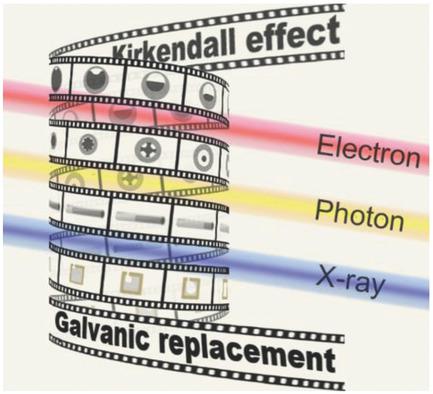当前位置:
X-MOL 学术
›
Small Methods
›
论文详情
Our official English website, www.x-mol.net, welcomes your feedback! (Note: you will need to create a separate account there.)
In Situ Techniques for Probing Kinetics and Mechanism of Hollowing Nanostructures through Direct Chemical Transformations
Small Methods ( IF 12.4 ) Pub Date : 2018-08-14 , DOI: 10.1002/smtd.201800165 Siyu Wu 1 , Yugang Sun 1
Small Methods ( IF 12.4 ) Pub Date : 2018-08-14 , DOI: 10.1002/smtd.201800165 Siyu Wu 1 , Yugang Sun 1
Affiliation

|
Chemical transformation of nanostructures into hollow ones becomes important in the synthesis of materials with unique properties for applications ranging from sensing to energy storage, to high‐performance catalysis. The nanoscale Kirkendall effect and galvanic replacement represent two typical mechanisms responsible for hollowing nanostructures. These two mechanisms occur either independently or simultaneously to form hollow nanostructures with appropriate geometries and desirable properties. Precisely distinguishing the hollowing mechanism and kinetics involved in a chemical transformation relies on in situ characterization methods including in situ electron microscopy, in situ optical spectroscopy, and a suite of in situ synchrotron X‐ray techniques (e.g., imaging, scattering, and X‐ray absorption fine structure spectroscopy). Here, the two typical hollowing mechanisms and the in situ characterization extensively explored in recent years are summarized, providing a timely overview of the promise of in situ methods in studying nanoparticle evolution under real reaction conditions.
中文翻译:

通过直接化学转化探测中空纳米结构的动力学和机理的原位技术
将纳米结构化学转化为空心结构,对于合成具有独特性能的材料至关重要,其应用范围从传感到能量存储,再到高性能催化。纳米级的肯肯德尔效应和电流置换代表了造成纳米结构空心化的两个典型机理。这两种机制独立地或同时地发生以形成具有适当的几何形状和期望的性质的中空纳米结构。精确区分化学转化涉及的中空机理和动力学依赖于原位表征方法,包括原位电子显微镜,原位光谱和一套原位同步加速器X射线技术(例如成像,散射和X-射线吸收精细结构光谱学)。这里,
更新日期:2018-08-14
中文翻译:

通过直接化学转化探测中空纳米结构的动力学和机理的原位技术
将纳米结构化学转化为空心结构,对于合成具有独特性能的材料至关重要,其应用范围从传感到能量存储,再到高性能催化。纳米级的肯肯德尔效应和电流置换代表了造成纳米结构空心化的两个典型机理。这两种机制独立地或同时地发生以形成具有适当的几何形状和期望的性质的中空纳米结构。精确区分化学转化涉及的中空机理和动力学依赖于原位表征方法,包括原位电子显微镜,原位光谱和一套原位同步加速器X射线技术(例如成像,散射和X-射线吸收精细结构光谱学)。这里,



























 京公网安备 11010802027423号
京公网安备 11010802027423号